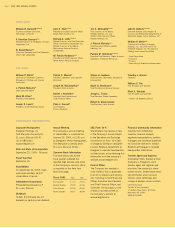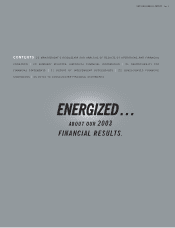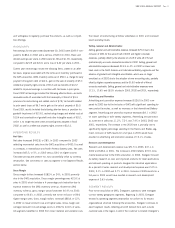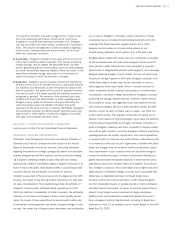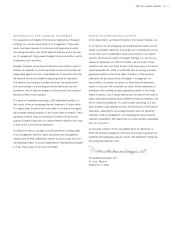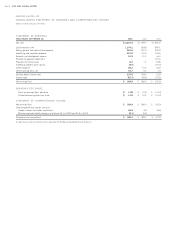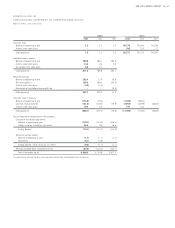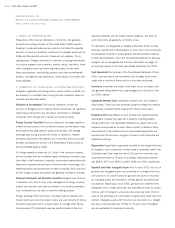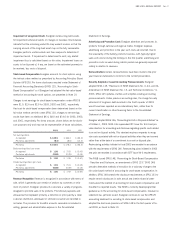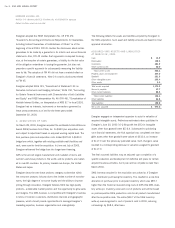Energizer 2003 Annual Report Download - page 20
Download and view the complete annual report
Please find page 20 of the 2003 Energizer annual report below. You can navigate through the pages in the report by either clicking on the pages listed below, or by using the keyword search tool below to find specific information within the annual report.Page 18 ENR 2003 ANNUAL REPORT
Energizer’s hedging strategy involves the use of natural hedging tech-
niques, where possible, such as the offsetting or netting of like foreign
currency cash flows. Where natural hedging techniques are not possible,
foreign currency derivatives with a duration of generally one year or less
may be used, including forward exchange contracts, purchased put and
call options, and zero-cost option collars. Energizer policy allows
foreign currency derivatives to be used only for identifiable foreign
currency exposures and, therefore, Energizer does not enter into
foreign currency contracts for trading purposes where the sole objective
is to generate profits. Energizer has not designated any financial instru-
ments as hedges for accounting purposes in the three years ended
September 30, 2003.
Market risk of foreign currency derivatives is the potential loss in fair
value of net currency positions for outstanding foreign currency contracts
at fiscal year-end, resulting from a hypothetical 10% adverse change in
all foreign currency exchange rates. Market risk does not include foreign
currency derivatives that hedge existing balance sheet exposures, as any
losses on these contracts would be fully offset by exchange gains on the
underlying exposures for which the contracts are designated as hedges.
Accordingly, the market risk of Energizer’s foreign currency derivatives at
September 30, 2003 and 2002 amounts to $1.7 and $0.9, respectively.
Energizer generally views its investments in foreign subsidiaries with
a functional currency other than the U.S. dollar as long-term. As a
result, Energizer does not generally hedge these net investments. Capital
structuring techniques are used to manage the net investment in foreign
currencies as necessary. Additionally, Energizer attempts to limit its U.S.
dollar net monetary liabilities in countries with unstable currencies. In
March 2002, Energizer contributed $8.4 of capital to its Argentine
subsidiary sufficient to repay all U.S. dollar liabilities in order to
mitigate exposure to currency exchange losses.
Stock Price
A portion of Energizer’s deferred compensation liabilities is based on
Energizer stock price and is subject to market risk. Energizer entered
into a prepaid share option with a financial institution to mitigate this
risk. The change in fair value of the prepaid share option is recorded in
selling, general and administrative expense. Changes in value of the pre-
paid share option should mitigate changes in the deferred compensation
liabilities tied to the Energizer stock price. Market value of the prepaid
share options was $39.7 and $25.5 at September 30, 2003 and
2002, respectively. The change in fair value of the prepaid share option
for the year ended September 30, 2003 and 2002 resulted in income
of $5.1 and $2.6, respectively.
CRITICAL ACCOUNTING POLICIES
Energizer identified the policies below as critical to its business opera-
tions and the understanding of its results of operations. The impact and
any associated risks related to these policies on its business operations
is discussed throughout Management’s Discussion and Analysis of
Results of Operations and Financial Condition where such policies affect
the reported and expected financial results.
Preparation of the financial statements in conformity with generally
accepted accounting principles (GAAP) in the United States requires
Energizer to make estimates and assumptions that affect the
reported amounts of assets and liabilities, disclosure of contingent
assets and liabilities and the reported amounts of revenues and
expenses. On an ongoing basis, Energizer evaluates its estimates,
including those related to customer programs and incentives, product
returns, bad debts, inventories, intangible assets and other long-lived
assets, income taxes, financing operations, restructuring, pensions and
other postretirement benefits, contingencies and acquisitions. Actual
results could differ from those estimates. This listing is not intended to
be a comprehensive list of all of Energizer’s accounting policies.
■ Revenue Recognition Energizer provides its customers a variety of
programs designed to promote sales of its products, many of which
require periodic payments and allowances based on estimated
results of specific programs. Such payments and allowances are
recorded as a reduction to net sales. Energizer accrues the estimat-
ed total payments and allowances at the time of sale associated
with each sale and continually assesses the adequacy of accruals
for program costs not yet paid. To the extent total program pay-
ments differ from estimates, adjustments may be necessary.
■ Allowance for Doubtful Accounts Energizer maintains an allowance
for doubtful accounts receivable for estimated losses resulting from
customers that are unable to meet their financial obligations. The
financial condition of specific customers is considered when estab-
lishing the allowance. Provisions to increase the allowance for
doubtful accounts are included in selling, general and administrative
expense. If actual bad debt losses exceed estimates, additional pro-
visions may be required in the future.
■ Pension Plans and Other Postretirement Benefits The determination of
Energizer’s obligation and expense for pension and other postretirement
benefits is dependent on certain assumptions developed by Energizer
and used by actuaries in calculating such amounts. Assumptions
include, among others, the discount rate, future salary increases and
the expected long-term rate of return on plan assets. Actual results that
differ from assumptions made are accumulated and amortized over
future periods and therefore, generally affect Energizer’s recognized
expense and recorded obligation in such future periods. Significant dif-
ferences in actual experience or significant changes in assumptions may
materially affect pension and other postretirement obligations.
■ Valuation of Long-Lived Assets Energizer periodically evaluates its
long-lived assets, including goodwill and intangible assets, for
potential impairment indicators. Judgments regarding the existence
ENERGIZER HOLDINGS, INC.
MANAGEMENT’S DISCUSSION AND ANALYSIS OF RESULTS OF OPERATIONS AND FINANCIAL CONDITION Continued
(Dollars in millions except per share and percentage data)


